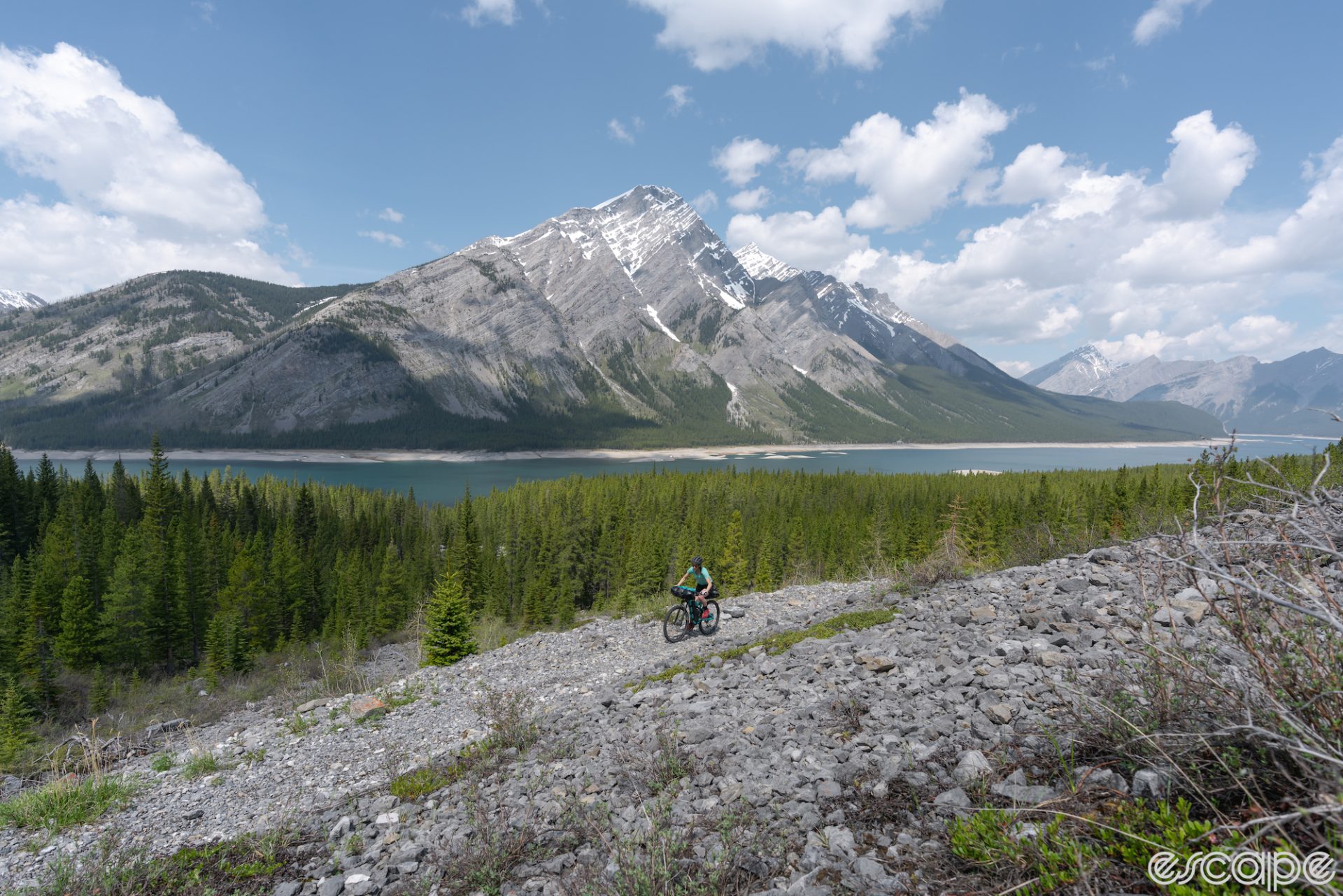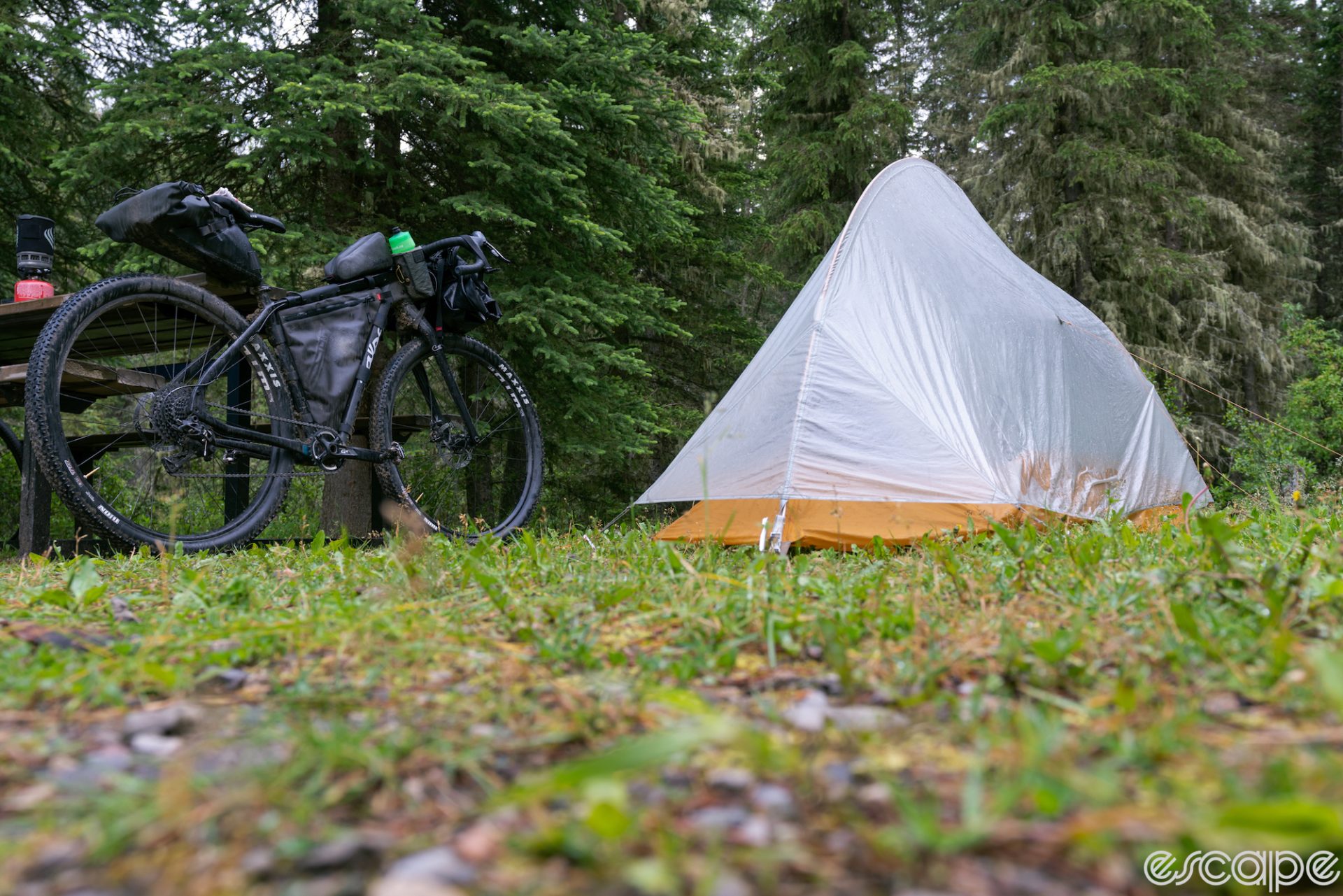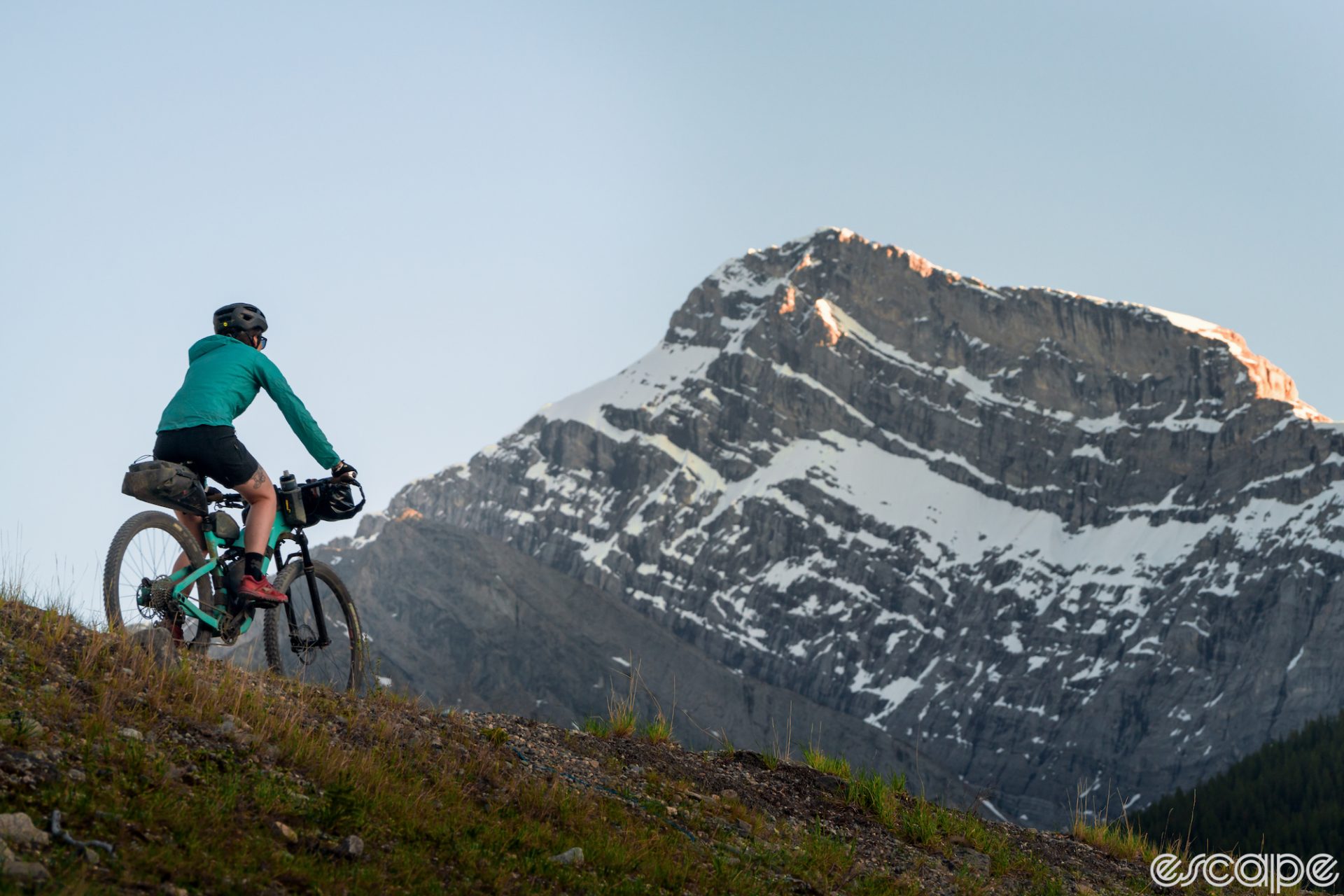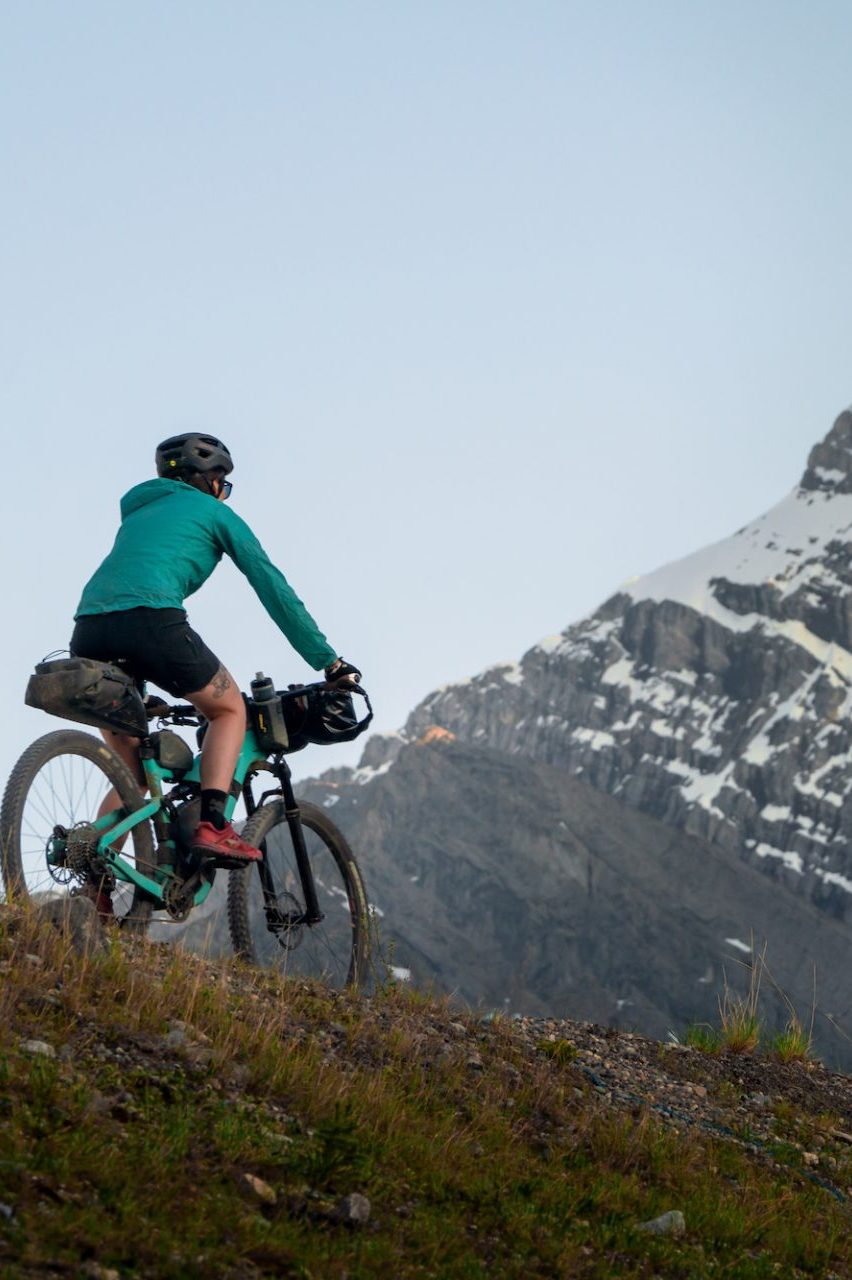Last June, a small group of bike racing fans was online eagerly following an event, as is often the case. But they weren’t watching the Critérium du Dauphiné or the Lenzerheide mountain bike World Cup. They were refreshing a webpage to follow 200 “dots” making their methodical way from Banff, Canada to Antelope Wells, New Mexico. Each dot was connected to a GPS tracker, carried by a cyclist, along with most of the gear needed to pedal 2,745 miles and climb 200,000 feet. Those cyclists were riding the Tour Divide–an event that entails biking for 2-4 weeks for 8-20 hours a day, subsisting on gas station food, and sleeping in the dirt.
The Tour Divide is both informal and highly anticipated, the start line is casual, there is no registration, no podium, and no entry fee. Riders agree to rules, such as not accepting help that anyone else couldn’t access – so they can check into a hotel or buy themselves a new rain jacket, but they can’t plan to have anyone meet them for support. The race runs on trust: “nothing to win or lose but honor,” as the rules outline. Given the informality though, this event draws in a global fan base and many international riders. It’s known for its ruggedness and holding a record or a win from this race is highly sought after in the world of ultra-endurance bikepacking.
We understand endurance sports come with benefits such as building strength, basking in those endorphins and pushing our perceived limits. But alongside this, most sporting events can also take a toll on our minds and bodies. An event like the Tour Divide, with its sheer distance and demands, brings this impact to another level.
Compared to the cycles of rest and recovery we are used to, what happens to a body when we choose to forgo recovery, almost entirely, for weeks on end? Physiologically, what’s happening and how do we measure if that impact is ultimately positive or negative for the body?
Ultra-endurance events are defined as any event that lasts longer than six hours. The Tour Divide laughs in the face of six hours. Six hours is a warm up for the next ten hours of riding that day, followed by another two weeks of the same pattern.
Barring the innumerable reasons a rider might drop out, these athletes can expect extreme exhaustion often paired with hallucinations, repetitive-use injuries, and a deep disruption to most systems of their body. Even when this event goes well, riders are steadily depleting themselves for weeks on end. The line between “going well” and not is thin, and can have profound, long-term effects on the body. But for a small group of hardy souls, there’s an irresistible draw that keeps them coming back.
The quiet before the long storm
Before starting a race like the Tour Divide, riders want to strike a balance between fitness and rest, knowing that they have done everything they can to be physically and mentally prepared for incredibly long days. For most Tour Divide athletes, their preparation and foray into endurance sports started years before they reached the start line. They have accumulated thousands of hours of pedaling and learning what their body and mind are capable of. Zoe Caliendo, a physical therapist and cyclist from Reno, Nevada says, “There’s so much focus on the ride itself but the real work comes from the year or years before.”
Two-time Tour Divide rider Hannah Dhonau says that in this long of an event, “The stakes feel higher. There’s a lot we can put up with for three days that we can’t put up with for two-plus weeks. So my focus was having a durable body. I wanted to ride a lot and ride when it wasn’t comfortable, whether that’s temperature or terrain. ‘How is this going to feel if it’s gritty? Or if it’s really hot?’” To train for that, Dhonau rode at unusual times of day, practiced riding at night, and left the house when no one else would think to ride.
More than even most bikepacking events or rides, conditions can change dramatically on the Tour Divide. This year, riders faced torrential rain, huge stretches of mud, ridiculous heat waves, and incredibly persistent head winds. Knowing how your body responds, how your gear works, and what you need to take care of yourself among such variability is key to maintaining momentum. Participants who had taken time to mentally and physically prepare for this type of adversity absolutely fared better.

The rigor of repetition
One of the obvious tolls of this ride is on the muscular system. The Tour Divide is a race of steadily moving at a relatively slow and sustainable speed. Riders will often say that even moving one mile an hour is better than stopping. The intensity is low, but the sheer duration of time spent moving forward is high.
Caliendo says that when we use our muscles, say in a gym setting, we create “micro damages and inflammation when we exercise.” This damage is repaired when we rest. When the muscle repairs itself, it can grow back stronger. So, after a big day of squats, you’ll leave the gym with tears in your muscles. Then, the time you spend sleeping or resting is when your muscle will repair itself and actually grow stronger.
Eliska Albrigtsen, an athlete and collegiate running and ski coach at the University of Alaska Fairbanks, adds that, “Normally we want inflammation in the muscles, it brings us strength in the end, as the muscle fibers break, they bring in inflammation which washes the weak muscle fibers out and new muscle fibers have space to grow and increase.”
We’re talking about [pedal] revolutions on a bike; it’s very one-dimensional and linear and repetitive.
-Zoe Caliendo
At an event like the Tour Divide though, recovery time is incredibly limited. Albrigtsen says, “Recovery is barely there so you do have to rethink how to approach it.” A small 2022 study of ultrarunners in an 11-day, 768 km event found elevated markers of muscle damage didn’t subside until nine days after the racers finished.
One of the 2023 Tour Divide’s fastest starters, former WorldTour road pro Ted King, ultimately dropped out of the race after experiencing the extreme end of muscle damage. Although King is an exquisitely fit elite athlete with lots of experience with the intensity of road racing, he’d done few multi-day ultra endurance events where – without the structure of stages – it’s up to each rider to decide their own 24-hour pacing and rest strategy. His approach was different to other riders: he planned to ride a harder pace, but stop about eight hours per day.
But after day four, he encountered what felt like “the ultimate bonk,” he recalls. “Just uncharacteristically empty.” He got dizzy on the bike and had a pulsing headache, and felt oddly bloated. “There was a strange puffiness under my eyes and my whole body was kind of swollen,” he says. A quick phone consultation with a friend who’s a physician sent him backtracking to Butte and the nearest hospital. King took some tests and was told he had rhabdomyolysis, (often called rhabdo) where damaged muscle tissue releases large amounts of proteins and electrolytes into the blood – a process that can cause severe damage to the heart and kidneys.
That highlights a unique risk of ultra racing. Our muscles recover with rest and intentional fueling, but ultra-racing’s self-paced structure puts riders in the position of making choices that may damage their health. Riders like King pushed themselves to exhaustion, causing severe muscle damage in an environment with limited access to high quality fuel and incredibly limited rest. Of note, another study of ultrarunners, from 2018, found signs of acute kidney damage, even though runners reported no clinical symptoms. King, thankfully, recovered with no long-term effects – in large part thanks, he thinks, to a vacation immediately after his Tour Divide experience that saw him off the bike for several weeks. He’s still unsure of his future ultra-racing plans.
King’s experience was unusual. But even for well-trained riders who avoid acute injury, Caliendo pointed out that the toll on the muscular system still adds up because “we’re talking about revolutions on a bike; it’s very one-dimensional and linear and repetitive.” Unlike other sports which may require more dynamic movements and bring in additional muscle groups, cycling is locked in. Our feet and hands stay in position and the motion is meditatively, or mind-numbingly, similar, often resulting in repetitive use injuries in addition to extreme muscle fatigue which will last for days or weeks after the event.

The heart of the matter
Our cardiovascular system consists of our hearts, blood, and blood vessels. When we exercise our heart rate increases, pumping more blood and energy to our cells to keep up with the exertion. During the Tour Divide, the steady pedaling movement elevates the rider’s heart rates for hours on end. While they are never sprinting or reaching a maximum heart rate, the consistent increased heart rate can have significant impacts.
Within cycling, most athletes and coaches use a model of five or six training zones based on heart rate and power. Zone 2 is similar in both of these models and constitutes the heart rate and power you can sustain for three hours. For heart rate, this number is based on your maximum heart rate. For most riders, this max HR number is somewhere in the range of 165-185 beats per minute (bpm). Zone 2 is defined as 60-70% of this number. So, for an athlete to keep their heart rate in Zone 2 they might aim for 100-130 bpm for the majority of the ride.
Moving outside of Zone 2, as Caliendo explains, means you’re breaking down more glycogen in your liver and in your muscles which increases your risk of bonking and changes your fueling needs.
The format of the Tour Divide can make this challenging. Caliendo points out that, “It could be really hard to stay in Zone 2 for long periods of time, day after day, because your body is working increasingly harder to stay there. Zone 2 pace on day two of this ride and Zone 2 pace on day 13 of this ride are going to look different. Your body is working so much harder to keep that pace.”
Additionally, the rider’s resting heart rates will increase during this event, indicative of the lack of recovery. “The reason your resting heart is higher is your body is working harder to heal from that effort. When you have days and days on top of that, your resting heart rate is increasing and it is actually harder to stay in lower heart rates because your resting rate is already up.”
Again, even when this ride goes well, the cardiovascular system takes a hit as it works overtime for days on end. Studies of ultra-endurance athletes suggest that long-term ultra-endurance exercise can create permanent changes in cardiovascular function, including myocardial fibrosis, or a scarring of muscle tissue in the heart. What’s more, most of the research is on ultrarunners in shorter events: 50 km to 200 km. There’s almost no scientific literature on weeks-long races where athletes are putting in 18-20 hours a day of effort.
Running on whatever fuel you can find
Since rest is so limited, fuel becomes extra important. However, this event also strips riders of access to most high quality food. It would be incredibly heavy and cumbersome to carry enough food for 2-4 weeks of riding, so participants stop at rural gas stations, maybe an occasional grocery store, or, if they dare, take a lavish break to actually sit down at a restaurant for a meal.
Some riders will carry energy bars they prefer, protein powder, or some dehydrated meals. For the most part though, this extra weight is deemed unnecessary and participants rummage through gas stations and hope their high-metabolism bodies can act like garbage disposals and eat up anything they can get down.
The recommendations for ultra endurance events (broadly defined as any event longer than six hours) offers some insight into the massive fueling needs on the Divide. Study after study finds that most athletes are under-consuming carbohydrates both before and during an event. For endurance events, researchers recommend that an athlete’s carbohydrate consumption sit around 90 g per hour. Leading up to the event, athletes are best positioned if they consume 10-12 g of carbohydrate per kg of body weight per day for numerous days before the event. The math becomes a bit nauseating, but if a 70 kg athlete aims to sit between this range of preparation for the next days and fueling needs for their current effort, they could be aiming to consume anywhere between 700 and 2,000 g of carbohydrates a day. For reference, an entire 14-inch pizza contains around 300 g of carbohydrates.
It’s pretty evident that replacing those energy stores through food alone is an almost hopeless battle. When asked about fueling, Dhonau says, “The whole event feels like an eating contest which is exhausting in its own way.” Not only is food availability limited, the sheer amount of calories, macronutrients, vitamins, and electrolytes these riders need is daunting. Eating requires significant attention, doing so while pedaling and minimizing stops only adds to the challenge.
Dhonau said, “I ate a ton of bars and candy and Pop-Tarts, so many Pop-Tarts, and whatever real-ish thing I could scrounge up. A lot of French fries, that kind of thing.” Lael Wilcox, the winner of the 2023 Women’s geared race this year, is known for downing half gallons of milk while sitting on the curb of a gas station. This event, again, forces us to rethink the complicated science around fueling and, instead, orient around the best-we-can-get in sub-optimal conditions.
Most riders, as they shove their pockets full of Snickers, are not considering the complicated manner in which our bodies access energy. The shortest burst of energy, like a hard throw or a five-second sprint, runs off of the phosphagen system, an anaerobic system which utilizes creatine phosphate and replenishes in a matter of minutes. For efforts which last a few minutes or less, the body primarily utilizes the glycolytic energy system, or the anaerobic lactate system, which runs on glucose (simple sugars) for fuel. For longer efforts, we run primarily on the oxidative, or aerobic, system, which uses carbs and fats in varying ratios. Our body moves in and out of each of these energy systems depending primarily on the time we’ve spent exercising and the intensity of exercise.
During extended exercise, we can run out of glycogen stores. At this point, our body will start making glucose from non-carbohydrate sources, a less-efficient and sometimes detrimental process. While we use all three energy systems simultaneously, the ratio and role of each depends on intensity and duration. Broadly, Albrigtsen explains, “You first burn carbs and sugars, then fats, and when the storages are depleted, your body starts taking your muscles apart for energy. Riding for two weeks will be digging into all of those energy storages at some point, which makes it important to replenish all of them. “Sugars are pretty easy to replenish if you eat every hour or so,” she says, adding that it’s far harder to ensure you’re getting enough fat and protein.
In order to keep moving day after day, riders have to somehow find enough quick carbs and sugars as well as enough quality fats and proteins. Folks will shove burgers in their pockets, spend $50 on gas station snacks for the day, continually eat gummy candy, or sit and drink multiple Gatorades on the side of the road.
The trick is to find the calories and hydration that will not hurt your stomach and are quick to eat – with bonus points for nutritional value. Riders also think about minimizing the food and trash they need to carry when they start riding again. The reality is this is a nearly impossible balance to strike and caloric deficit is nearly unavoidable, further minimizing recovery.

The physical and mental limits
Riding for up to 20 hours a day means sleep deprivation is inevitable. Caliendo says, “Sleep is kind of the base of health. Everything kind of sits on sleep.” If the amount of riding wasn’t enough, the lack of sleep compounds every challenge riders face. Of note, a 2022 study of ultrarunners published in Frontiers in Physiology – which also looked at cardiovascular function – found significant deterioration in cognitive abilities: not only did memory decline, but reaction times increased by 30 percent on average, and athletes were similarly delayed in decision-making tests.
As Caliendo says, “Lack of sleep is going to affect memory, your self-control, your decision-making. And as you add fatigued muscles which is going to decrease your balance, your proprioception, your ability to react.” Additionally, Caliendo points out that such extreme fatigue will affect blood sugar management, certain hormone cycles, and our immune system function. Each of these systems will settle back to normal, but riders can expect this process to take significant time after the event.
Dhonau says that she planned to sleep around four hours a night for races as long as the Tour Divide. She notes that the fatigue is intense to adapt to: “At first everything feels so hard and I felt like my body just hated it. Then I got to a spot where I was really fit but not too depleted. Colorado, for me, felt great. There’s a sweet spot where I felt really fit and the cumulative fatigue didn’t feel as terrible. By the end though, I was so tired but also had my systems dialed. I knew exactly what I needed at the gas station, I knew exactly what to do every time I stopped. In some ways autopilot took over, so I was doing it but my body definitely wanted to stop soon.”
Everything just feels more acute – emotions just feel so much bigger.
-Hannah Dhonau
Beyond even the physical demands of the race, the mental demands may be an even tougher beast to slay.
One study, published in PLoS One, looked into the mental toughness of ultra endurance athletes – in this case ultra runners competing in a 100-mile trail run, still a notably shorter event than a race like the Tour Divide. However, researchers found that athletes who entered this event self-reported significantly higher rates of self-efficacy and mental toughness than athletes who competed in shorter distance events. Interestingly, higher rates of self-efficacy and mental toughness did not have significant impacts for where a competitor placed within the field or even if a competitor would finish the race, implying that there is a threshold of mental strength to get an athlete to the start line, but past that point, other factors are likely more influential.
Caliendo agreed, saying, “The mental resilience is probably one of the most important pieces for these riders. There is going to be a lot of pain and discomfort, you’re going to want to crawl into a bed. That mental resilience is really what you need to even train for a ride like this.”
Even when things are going fine, emotions can feel magnified. Dhonau notes how wild it was to be with her thoughts for weeks on end with not much more to do than pedal. “Everything just feels more acute – emotions just feel so much bigger,” she says. “Joy and frustration and everything just feels big.”
An obsession, healthy or otherwise
So with all that, are extreme ultra-distance races like Tour Divide good for us, or should we be more aware of its potential for harm? This type of endurance event offers a space of both/and, both knowing that sleep deprivation is bad and continuing forward, both tuning into what you need to eat to optimally refuel and recognizing you have to compromise in that 7-11 at midnight, both understanding when you absolutely must sleep and pushing to this very edge, both recognizing and fixing physical problems and crossing your fingers that they might just go away on their own if you’re lucky.
Both physically and mentally, in a race like Tour Divide the body becomes the vehicle and the driver, push-pulling along the entire Continental Divide. Riders fight the elements; battle deep physical, mental, and emotional fatigue; injury; gastrointestinal distress; and still feel the draw to continue, fueled by a profound mental toughness. That changes riders for the long-term, and it’s an open question how much of that is good versus not.
Despite the continual narrative that sports are beneficial, riders like Dhonau know that the physical effects are likely detrimental for overall health and longevity. Body systems protest for days on end, even after finishing. Pushing to the point of hallucination, severely limiting recovery, and remaining fixed in one pedaling position for weeks is a huge feat that also comes with negative health ramifications.
And yet, for a small group of hardy souls, they are continually drawn to it. As King observes, only a few percent of the entrants in a race like the Tour Divide (or even Unbound) are lining up with thoughts of winning it. “The rest are there for reasons to prove something to themselves,” he says, “to see if they can make it to the finish line” basically. And once they do, “the majority of people want to do it again, and challenge themselves to do it faster, to improve.”
The Tour Divide may be an entirely different kind of event, but it’s still a competitive one, even if that competition is only with ourselves. Once we release the expectation that something like the Tour Divide is solely good for us, maybe it opens up the idea that this race might just fill a different space, one where grit and intuition keep people coming back for more.
What did you think of this story?

